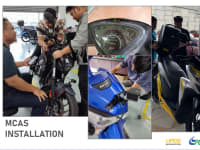The alarming increase in road deaths and injuries involving powered two- and three-wheeled vehicles (PTWs), is compounded by the lack of sustainable solutions to curb the occurrence. In many low- and middle-income countries, PTW deaths account for 43% of all road traffic deaths. In Malaysia, more than 48,000 deaths involving PTW users were recorded for the past 11 years. Our PTW pre-collision warning system is a promising solution to this problem. The system (called MCAS) can be retrofitted seamlessly to most of existing PTW models.
The MCAS system uses a LiDAR sensor (maximum detection range = 180 m, accuracy = ± 15 cm), coupled with a GPS module to monitor the forward travel path of a PTW. The system provides visual and auditory alerts that increase in intensity as the hazard gets closer. The initial, and lowest alert is a more benign visual alert (green color LED) provided at a further distance from the hazard. Assuming a trajectory change to a clear path is not initiated, the visual alert turns from green to amber and red color and a more intense auditory alert follows.
The MCAS system is novel in the sense that it uses a combination of LiDAR and GPS to provide a more accurate and reliable warning system for PTWs. The use of LiDAR allows the system to detect objects in the dark and in poor weather conditions, while the GPS module ensures that the activation of system can be made customizable based on riding speeds and time to collision, thereby increasing user acceptance of the technology.
Most existing systems rely on radar or ultrasonic sensors, which have a limited range. LiDAR on the other hand, has a much longer range and is less likely to be fooled by false positives. In addition, the MCAS’s graduated alert system is a more effective approach than simply using a single alert.
MCAS has shown promising potential in terms of collision avoidance and safer riding behaviours. A cohort of 20 MCAS users reported that MCAS has helped them to avoid a total of 899 potential collisions, over a cumulative 70,000 km distance on the roads. Our data have shown 67.3% reduction of sudden braking events (SBEs) and 57.2% reduction of safety critical events (SCEs) post MCAS installation compared to three months prior to installation. MCAS has influenced the use of safer riding speeds (78.2% of time), helped improve alertness (86.5% of time), and prevented risk taking (86.7% of time) and risky overtaking (75% of time).
The cost to install a unit of MCAS is estimated at MYR 2,500 or around USD 550 but can be made more cost-effective. There is a well-defined market for the use of MCAS especially in countries with high PTWs ridership. According to research, the demand for motorcycle accessories and parts is proportional to the production of motorcycles. The market for MCAS is expected to continue in the coming years especially in the Southeast Asian region, where 14 million total motorcycle sales were estimated in 2022 alone.
Video
Like this entry?
-
About the Entrant
- Name:Mohd Khairul Alhapiz Ibrahim
- Type of entry:teamTeam members:
- Muhammad Hazazi Saidpudin
- Muhammad Hafidz Basir
- Nik Muhammad Arshad Nik Mansoor
- Muhamad Haziq Hairul Shah
- Nurul Nashuha Khairul Emran
- Azhar Hamzah
- Khairil Anwar Abu Kassim
- Noordini Harliyati Ramli
- Richard Hanowski
- Software used for this entry:Arduino IDE 2.1.0
- Patent status:pending









